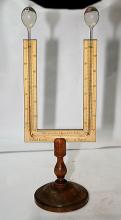A glass tube having a large bulb at each extremity, and bent twice at right angles containing strong sulphuric acid tinged with carmine, and supported at the centre by a wooden stand, constitutes the differential thermometer as invented by Professor Leslie. The instrument is designed to exhibit and measure small differences of temperature. Each leg of the instrument is usually from three to six inches long, and the balls are about four inches apart. The calibre of the legs is about 1 ⁄ 50 inch, not more, the other part of the tube may be wider. The tube is filled with the liquid, the bulbs contain air. When both bulbs are heated alike, each scale indicates zero. The scale is divided so that the space between the freezing and the boiling-points of water is equal to 1,000 parts. When one bulb is heated more than the other, the difference of temperature is delicately shown by the descent of the coloured fluid from the heated ball. It is uninfluenced by changes in the temperature of the atmosphere hence it is admirably adapted for experiments of radiant heat. The theory of the instrument is that gases expand equally for uniform increments of heat.

